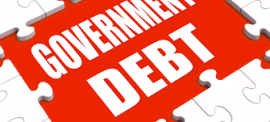Finance Minister Enoch Godongwana says government debt is projected to be more than R4.7 trillion in the current financial year, compared to R627 billion in 2008/09.
This debt, he said, was incurring debt-service costs that will average R355.2 billion per year over the medium-term expenditure framework.
He said: “The global economy is slowing, inflation is increasing, and financial markets are becoming more volatile. The result is that the debt-service costs are estimated to be R5.9 billion higher in 2022/23 than what we thought at the time of the February budget.
Moreover, the possibility of a major price correction in financial markets is a significant risk.
“This will affect fiscal revenues going forward,” he said.
The Minister told Members of Parliament that the country’s medium-term strategy needed to maintain a prudent approach to fiscal policy.
“We need to decrease our debt burden and debt-service costs by reducing our annual deficits. This will stabilise the public finances and reduce the fiscal risks.”
In this regard, he said progress was being made.
“A consolidated fiscal deficit of 4.9% of GDP is projected in 2022/23. This will decline to 3.2% of GDP by 2025/26. A primary fiscal surplus of 0.7% of GDP will be achieved in 2023/24. This is one year earlier than projected at the 2021 MTBPS. We also now expect gross government debt to stabilise at 71.4% of GDP in 2022/23 — two years earlier, and at a lower level, than projected in the 2022 Budget Review.
“Among other things, this means that we are proposing that no budget reductions are implemented in the 2023 Budget. In fact, consolidated government spending will exceed R2.2 trillion this year and will rise to R2.5 trillion in 2025/26.
Medium-term fiscal strategy
If National Treasury projections are anything to go by, the South African government will in the next financial year achieve its first primary budget surplus in 15 years.
The department in Godongwana’s 2022 Medium Term Budget Policy Statement (MTBPS) said over the past several years, government’s efforts to stabilise debt and narrow the budget deficit were interrupted by a series of shocks that required urgent fiscal allocations – most notably by the near collapse of Eskom in 2019/20 and the COVID-19 pandemic in 2020/21.
In the document, which Godongwana delivered to the National Assembly on Wednesday, the Treasury said the pressures were managed primarily by reallocating funding within the budget and establishing firm expenditure ceilings.
In this regard, the department said the medium-term fiscal strategy prioritises:
Achieving fiscal sustainability by narrowing the budget deficit and stabilising debt.
Increasing spending on policy priorities such as security and infrastructure, thereby promoting economic growth.
Reducing fiscal and economic risks, including through targeted support to key public entities and building fiscal buffers for future shocks.
Over the next three years, the Treasury said spending increases would support economic growth and the delivery of health, education and local government free basic services.
“Main budget non-interest spending will grow slightly above CPI inflation in 2024/25 and 2025/26 as more resources are added to key baselines for delivery of services, infrastructure, and safety and security – and funds are set aside to reduce fiscal risks.












